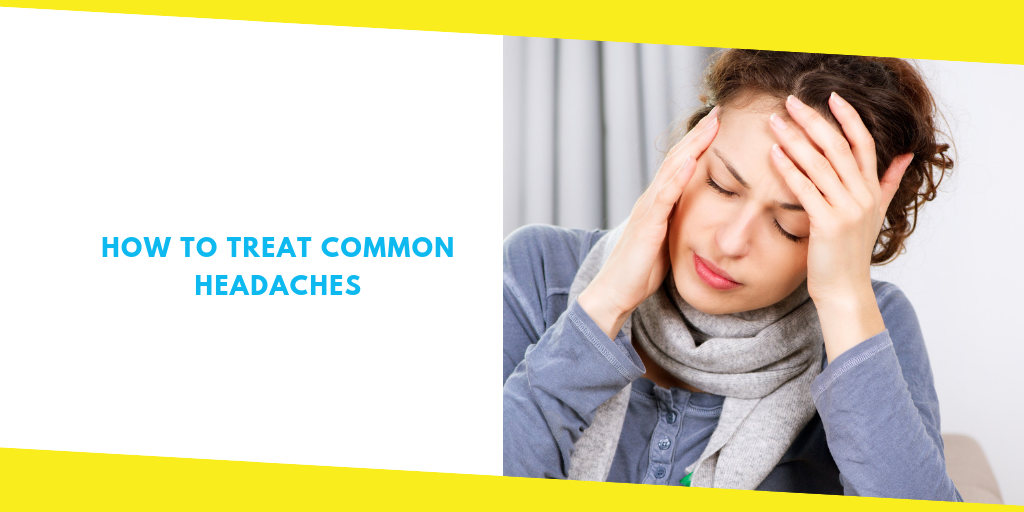Common Headaches And Ways To Treat Them

Headaches are not fun. With more than 300 types most people have experienced one form of a headache or another. Don’t despair though, there are ways to treat headaches and we’ll be covering the most common (or primary) types and what to do about them.
There are three main types of primary headaches. These include tension headaches, migraines, and cluster headaches. See which symptoms you identify with and what you need to do to live headache-free.
Contents
ToggleTension headaches
Tension headaches don’t throb. You’ll feel pain all over your head and these types of headaches are most likely caused by stress. An over-the-counter (OTC) pain reliever should do the trick to sort your headache out but you may need to get prescription medication from your doctor if that doesn’t help.
If a headache is chronic the doctor may suggest something else to treat the underlying cause. For managing your triggers see further on, some advice regarding triggers may be helpful to avoid getting this type of headache again.
Migraines
Migraines are different to tension headaches because they throb or pulsate. Usually, they are one-sided and often start in the evening or during the night while asleep. They can go on for days and can cause visual disturbances (known as auras). Nausea is common with migraines. A watering eye, running nose or congestion can occur too.
Treating migraines can be tricky. If you happen to catch it early, nonprescription pain relievers may work but if that doesn’t sort out the problem a doctor will probably prescribe triptans. Triptans are available as tablets, nasal sprays or injections. Again, it’s important to manage your triggers see more about this in the section below, ‘manage your triggers’.
If you suffer frequent attacks the doctor will probably prescribe preventative medications such as beta-blockers, certain antidepressants or anti-seizure medication. If you’re still battling you may be referred to a headache specialist.
Cluster headaches
Cluster headaches come on very quickly, as fast as 5 to 10 minutes. These occur in short episodes from about 15 minutes to 3 hours in length usually with a burning or piercing pain behind one eye. Also known as ‘alarm clock headaches’ they generally occur at the same time every day/year and can go on for weeks or months at a time.
Inhaling pure oxygen is effective for treating cluster headaches but other approaches may need to be considered. It’s best to speak to your doctor to see what medication will work best for you.
Manage your triggers
There are certain common triggers that can cause headaches. Check your eyesight and diet and manage stress to avoid burnout and fatigue. It’s also imperative to make sure you drink lots of water and are not dehydrated. Also, don’t forget to check your posture to make sure you are sitting properly. That means no slouching! A good ergonomic chair can make a difference as well as getting up and walking around every 45 minutes.
Stretching is vital if you suffer from tense muscles and going for regular massages can ease stiff muscles. Cutting down on your caffeine intake can also be beneficial for treating headaches, so give that a try too if you’ve tried all the other methods mentioned above.
Interestingly a change in weather can bring on a headache too particularly heat or humidity as can travelling where changes in the environment and sleep patterns can aggravate or cause a headache.
Home remedies
There are some home remedies to fight headaches such as using essential oils (think calming lavender or uplifting peppermint) and hot or cold packs but remember if your headache is severe or one of the worst you’ve experienced it’s best to seek medical advice.
There’s more…
For more in-depth information about headaches read further on Wikipedia. It covers secondary causes of headaches too and is helpful to read if you don’t have a primary headache.
Primary headaches are not dangerous but secondary headaches can be, so do monitor your symptoms closely and check if they match secondary headache characteristics.
If you are experiencing a stiff neck, rash, vomiting, confusion, slurred speech, a fever, paralysis in any part of your body or visual loss please seek immediate medical attention.
Recommended For You
PDO Threads Lift: Benefits, Recovery, and Risks
Most Inside
Most Inside offers high-quality recommendations and valuable updates to enhance all aspects of your life, providing premium guidance and enriching experiences.




